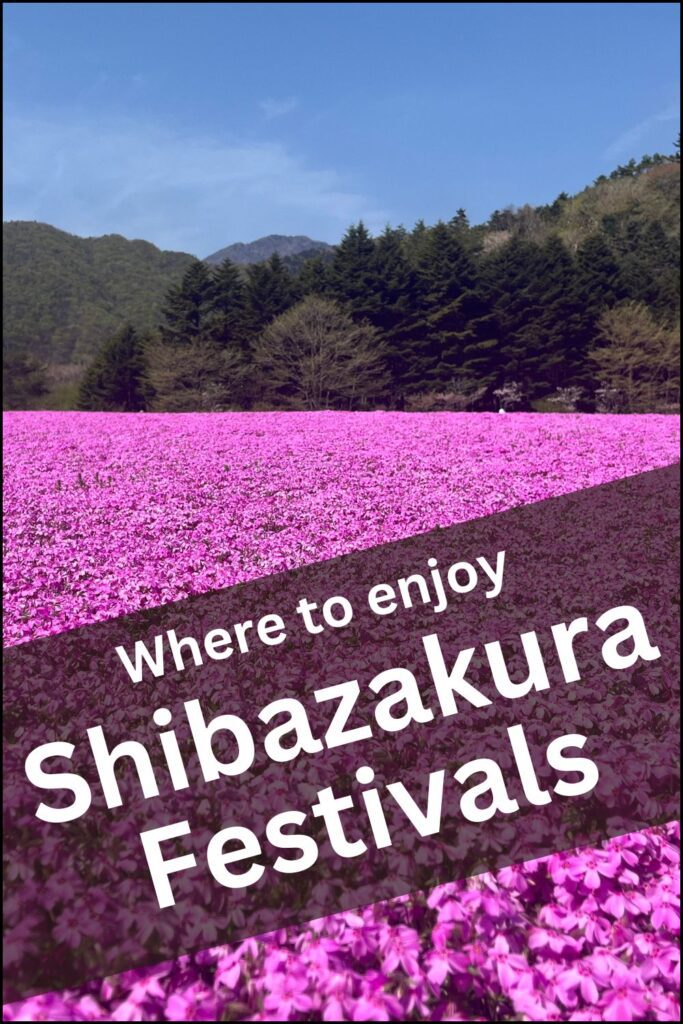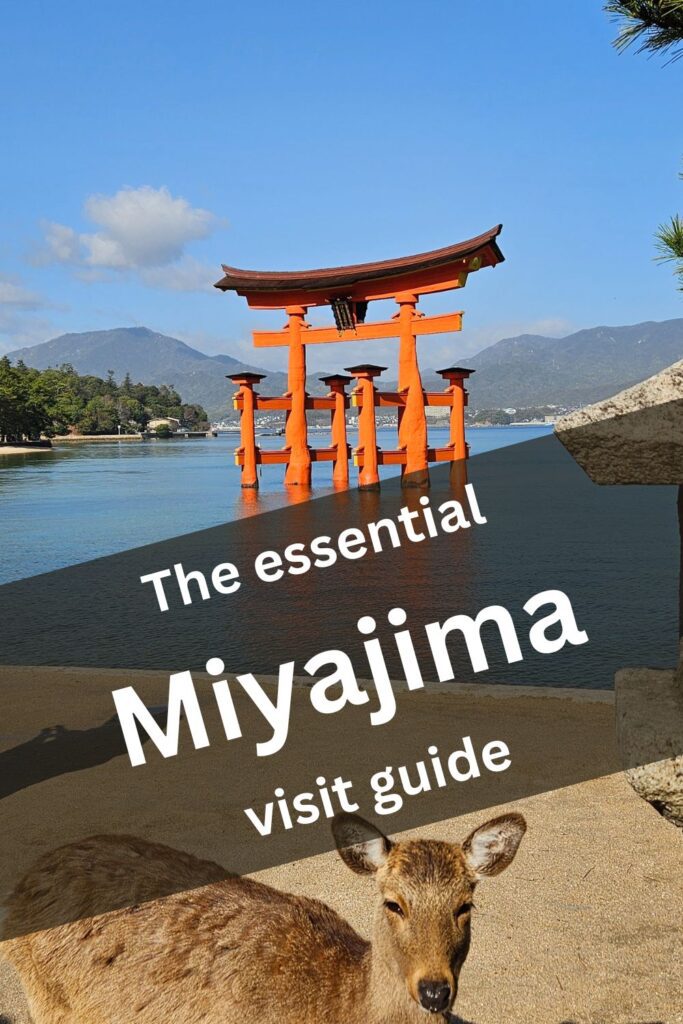Fuji-san, or Mount Fuji, is the icon of Japan and hardly needs an introduction. It’s silhouette makes it arguably the most famous mountain in the world, certainly the most recognizable.
With its almost perfectly symmetrical cone, imposing height, and beautiful snow crown, it’s easy to understand why this rock formation is considered sacred and the residence of deities. More precisely, it is an actual manifestation of a kami, specifically Konohanasakuya-hime, the goddess of volcanoes and the blossom princess (for more info on Shinto religion, check out my visitor guide to religious etiquette).
The view of Fuji never gets old, and every small change is a sight to behold and enjoy. Even as a visitor from another religion or atheist, it is easy to quickly personify Fuji once you see it. A small cloud near its snowy head can be seen as a cap. Larger clouds embracing it can be seen as the mountain covering its modesty or sleeping. And when the clouds open up and the sunrays touch its snowy crown, they reflect back at you, carrying with them the majestic, awe-inspiring beauty of Fujisan. A real manifestation of the divine

Surrounding Mount Fuji are five lakes, commonly called Fujigoko in Japanese, created around 2000 years ago by the volcano’s eruptions which blocked lava flows to the sea. These are Lake Yamanaka (山中湖), Lake Kawaguchi (河口湖), Lake Sai (西湖), Lake Shoji (精進湖) and Lake Motosu (本栖湖).
Visitors often go to Lake Kawaguchi, only a few hours of train ride from Tokyo, to see the beautiful lake and mountain if they are lucky, and head back. However, there is much more to enjoy as each lake has its own specific charm, and spending multiple days there allows one to recharge, relax in ryokans, bathe in onsens, stroll the many shores, enjoying their quiet tranquility, while always being at the footsteps of the awe-inspiring mountain.
I visited the area like most, by train from Tokyo and with a 1-day stop at Kawaguchi in a traditional Ryokan. However, there was no way of seeing anything as there were heavy clouds and rainfall. I walked around early in the mornings and all day and evenings, but the fickle mountain would not reveal itself.
With understandable disappointment, I proceeded with my visit to Japan as I was on a “cherry blossoms hunt” and wanted to see as many Sakura spots as possible. After visiting Kyoto, Nara, Himeji, Osaka, Nagoya, Kanazawa, and Takayama, and after even the flowery pink carpets had gone, making way for the green leaves, the missed view of Fuji started to creep into the back of my mind.
So instead of proceeding, I went back to Tokyo, stayed there for a week, got my driver’s license in Japanese translation, and managed to book a car (actually a huge van since it was the only car available in the entire region during Japan’s Golden Week), and headed back to the region.
As if rewarding my persistent stubbornness, the second time I visited, the weather was always incredible, and I got to spend hours upon hours just admiring Fuji from every possible angle: parks on the side of the road, on the shore of lakes with fellow fishermen, campsites, pink moss blossom festivals, shrines, and pagodas. After 4 days, I proceeded to Nikko, but I would have happily stayed there much longer.
What to expect
- Nothing can prepare you for the sight and sheer size of Mount Fuji. Photos don’t do it justice. You will wander around until suddenly you will see it, and nothing else, right in front of you.
- Peaceful and awe-inspiring nature
- Fickle weather
- There are very few restaurants, generally with strange opening hours and ever-strange “closed/full/out of stock” policies. It is common throughout Japan, but here even more, to get something to eat at a 7Eleven or Lawson and take it to your room.
- Many hotels feature traditional Japanese Ryokans with tatamis and futon beds, and many of them with onsens, natural springs, and public baths.
- A vacation destination that hosts several festivals year-round. From the Cherry Blossom Festival and Fuji Shibazakura/Pink Moss in spring to several summer fireworks festivals, to the Autumn Leaves Festival in fall
- Each lake has its own unique charm and is best for specific activities. Water sports can be found at the larger lakes Kawaguchi and Yamanaka, while at the more quiet lakes Shoji and Sai, people fly fishing and camping on their shores.
Tips & Impressions
- Fuji was something of a peak experience for me. I had tried to see it at the end of April, but it was completely covered in clouds. I went back one month later with a car. The drive and radio seemed to be in sync with my approach, playing calm classical music when I was just getting outside of Tokyo and trying to cope with the size of the van, the driving direction, the unintelligible road signs, and all the small things that can make one anxious when driving for the first time in a foreign country. As I approached the lakes around Otsuki, the music changed to Japanese pop songs, all joyful, cheerful, and energetic, making me feel like I was in an anime. The last song was a somber chorus singing “Sakura,” which played right as I exited a tunnel and was met with the immense mountain right in front of me. From then on, my eyes were more on Fuji than on the road. I drove silently admiring it until my hotel at Lake Shoji, and when I entered the ryokan, I opened the window blinds, and there it was again, right in front of me. I boiled some water, made some tea, looked at it, and spent the next 4 days doing the same thing.
- With respect to the Fuji Shibazakura festival, I was expecting a large crowd, and sure, there were many people already at opening time at 9. However, the beauty of Japan is the silence that pervades almost everywhere, and here is no different. Only the occasional clicking sounds of the camera and small, modest laughs of joy and wows of amazement surrounded me, together with the carpets of pink moss phlox.
Safety
- Safety: There aren’t any risks, with the exception of the potential eruption of the volcano. The last eruption was in 1707, and as all volcanoes are not considered completely extinct but rather dormant, an eruption is bound to take place in the future. That being said, meteor and lightning strikes can happen, so there is no reason to worry.
- Emergencies number: 911
Getting around
- Reaching the five lakes is by no means difficult but strangely less easy than one would expect given the stellar and capillary train system of Japan. Most often reaching the lakes is done through the JR line from Tokyo and changing at Otsuki. This will bring visitors to Kawaguchiko station where one can explore the surrounding areas by bus.
- There are 3 sightseeing bus lines: red, green, and blue with the red remaining in the area surrounding Lake Kawaguchi, Green going to Saiko, and blue going all the way to Shojiko and Motosuko. For Yamanaka, the brown, green, and orange lines can be used
- Kawaguchiko is the door to Lake Kawaguchi, the most famous of the 5 lakes and what most visitors come here for. A day trip to Kawaguchi allows one to see Fuji-san from many of the viewing spots on the wonderful lake.
Check the Driving in Japan page for more driving tips and information

Trivia pill
In basically every article on Japan I repeat the point about the silence and how everything is quiet. However, in touristic places, there is an ever-present noise: the sound of camera shutters clicking.
Every smartphone bought in Japan makes a shutter sound when taking a picture (and most have an increasing volume of the sound the more photos are taken in quick succession). This cannot be disabled. Japan is arguably the country where cameras started (remember in the 80s and 90s how it used to be a joke talking about Japanese tourists taking photographs of everything?) and the photography culture is deeply embedded in the fabric of society. This is to preserve privacy and combat voyeurism as there have been many publicized issues of photos of girls taken under their skirts and other similar creepy things. So yeah, if someone tries to sneakily take a picture of you, you will hear it. Conversely, if someone is pointing their phone at you and staring into it but you don’t hear shutter sounds, they are just casually browsing and you should not feel attacked in your privacy.
Weather
Japan is well known and proud of its four distinct seasons and how the natural landscape changes during each part of the year. Whether visiting the area when it is covered in snow during winter, or immersed in exploding colors and cherry blossoms during spring, or surrounded by brightly red autumn leaves, Fujigoko is always spectacular. Even summer, the worst season for Japan given its immense heat and humidity (as well as typhoons at the end of the season), is great around Fuji.
There are many festivals held at Fujigoko. In summer, in July when the climbing season of Mount Fuji starts, there is a large display of fireworks. August also has many fireworks festivals around the country and the Five Lakes are no different with their Fuji Five Lakes Fireworks Festival where every evening a different lake showcases a fireworks spectacle.
In spring, during cherry blossom season, the Fuji Kawaguchiko Cherry Blossoms Festival is held, where you can walk among thousands of Sakura trees, with the everpresent magnificent mountain in the backdrop. There is also another cherry blossom festival at the Arakurayama Sengen Park under the Chureito Pagoda. These festivals not only allow to walk within the spectacular trees, but the streets are lined with street food carts, people having picnics and enjoying hanami, and is just a great moment of visible fun and entertainment.
Like in spring where hanami is word for the enjoyment of cherry blossoms, in autumn, the Momijigari, is the strolling among the Japanese maple tree acers whose leaves turn red, yellow, and orange in a spectacle of red-shifted colors.
Also here, the Autumn Leaves Festival is held at Lake Kawaguchi, at the aptly named “Momiji corridor” with another Autumn Leaves Festival held at Lake Yamanako.
Etiquette
As with many places in Japan, the common courtesy is to be modest and respectful, especially when it comes to noise. This is easy to achieve as even staying in Tokyo – the largest city in the world – you will hardly hear people talk louder than a whisper.
Because the lakes are a vacation destination, for fishing, camping, strolling on their shores and generally being within nature, it is important to not treat the places as theme parks making noise and chaos which can disturb the other visitors.
That being said and despite Fuji being a sacred symbol, there is no particular need for “over respect”. You will see many (many) people taking hundreds of pictures, enjoying the views, turning their backs to the mountain, and taking funny selfies.
So basically treat the areas you would with any other nature location (except clearly when going into shrines and temples which require religious etiquette).
Offers
The Lakes

Kawaguchiko: The most famous of the 5 lakes, it hosts the iconic Chureito Pagoda.
Saiko: A small and tranquil lake great for camping and fishing.
Shojiko: The smallest of the lakes, and the closest to the Aokigahara forest.
Motosuko: The deepest lake and home to the amazing famous pink moss festival.
Yamanakako: The largest of the lakes and great for water activities such as boating, water-skiing, and windsurfing.
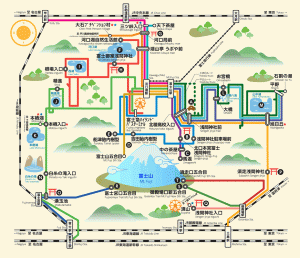
All the lakes are relatively close to each other and there is an extensive bus network that allows to travel between the various spots.
There are 3 sightseeing bus lines: red, green, and blue with the red remaining in the area surrounding Lake Kawaguchi, Green going to Saiko, and blue going all the way to Shojiko and Motosuko. For Yamanaka, the brown, green, and orange lines can be used.
Lake Kawaguchi
河口湖
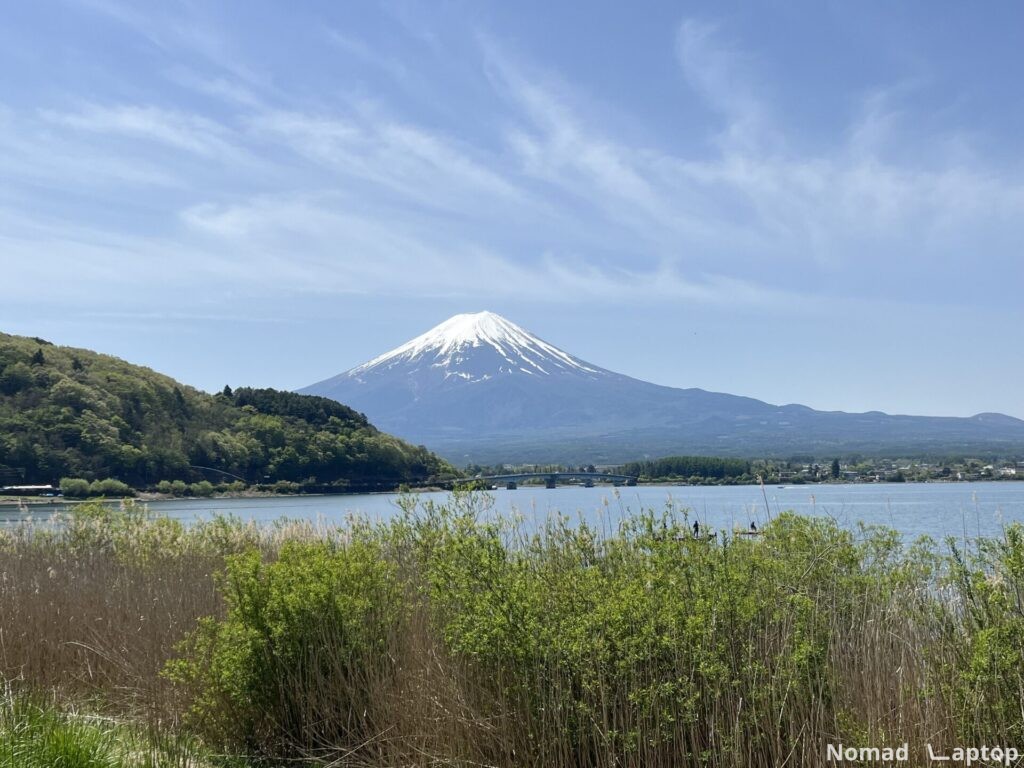
As said earlier lake Kawaguchi is the most famous of the 5 lakes and the one that holds most attractions. It is also the only one with an island in its center.
If you are planning on staying at the Five Lakes for only 1 day or making it a day trip, chances are you will be going to Kawaguchi.
Popular sites include Nagasaki and Oishi parks, both on the shores of the lake. The famous Chureito Pagoda which stands at the top of Fuji Sengen Shrine, and the Fuji Panoramic Ropeway.
On the way to Oishi Park there are some small shrines, a picturesque Garden terrace cafe, and a curious “music forest” museum.
Chureito Pagoda

The Chureito Pagoda (忠霊塔, Chūreitō) is a five-storied pagoda on the mountainside overlooking Fujiyoshida City and is located in Sengen Park. The pagoda is part of the Arakura Sengen Shrine and was built as a peace memorial in 1963.
Reaching the pagoda is by no means a hike but the nearly 400 steps up Arakura-yama (Mt Arakura) will certainly leave you out of breath. Luckily when you reach the top, the observation deck offers spectacular views of Mount Fuji in the distance with the pagoda in front. It is especially beautiful in spring during cherry blossom season and in autumn when the red and orange hues of the surrounding trees surround the area.
This location is one of the most photographed spots in Japan as it combines some of the most classic and stereotypical aspects of the country.
Lake Shōji & Lake Sai
西湖 , 精進湖

When I returned after a month I stayed at a ryokan at Lake Shoji. The room had a wonderful view of Mount Fuji, which this time was always clearly visible and greeted me every time I looked out the window.
Lake Shoji is small and tranquil, with almost no restaurants, a single hotel, and very few passing cars. It is a perfect place to relax and enjoy the view of Fuji-yama.
The same can be said for Lake Sai. This offers lower visibility of Fuji-yama depending on which shore you stay at. Nearby Saiko is the village of Saiko Iyashi no Sato – an open-air museum recreating an old Japanese village.
Aokigahara Forest
Both lakes are near and within the famous Aokigahara forest. Also known as Jukai (“sea of trees”), this forest is almost unique and definitely worth a visit. Its name aptly recalls the number of intertwining trees and is incredibly dense. Not only that but it is located on top of magma from the last eruption of Fuji, making the ground brittle with lavic rocks. The combination of the porous rocks and moss carpeting the ground and the thick tree canopy gives the forest an eerie quality, with sounds almost muted.
Many lava caverns and lava tunnels are present in Aokigahara such as Bat Cave, Ice Cave, Wind Cave, and Dragon Cave). All of these are an interesting addition to the hike in the forest (take note that they are very cold with temperatures between 0-4 degrees).
Aokigahara is also infamous as Japan’s suicide forest, with several dozens of suicides occurring in it yearly. This is because of many reasons, such as the density and secludedness, its eerie quality which itself is depressing, the name it has acquired, and the historical and legendary aspects to it as it was considered also in ancient times as a haunted forest. It is believed that ubasute was done in Aokigahara, which was the practice of senicide of taking elders in forests or mountains and abandoning them there. This gave rise to the belief that the forest is haunted by the spirits of ancient dead people (as well as the rising number of yearly deaths that occur there).
Lake Motosu
本栖湖
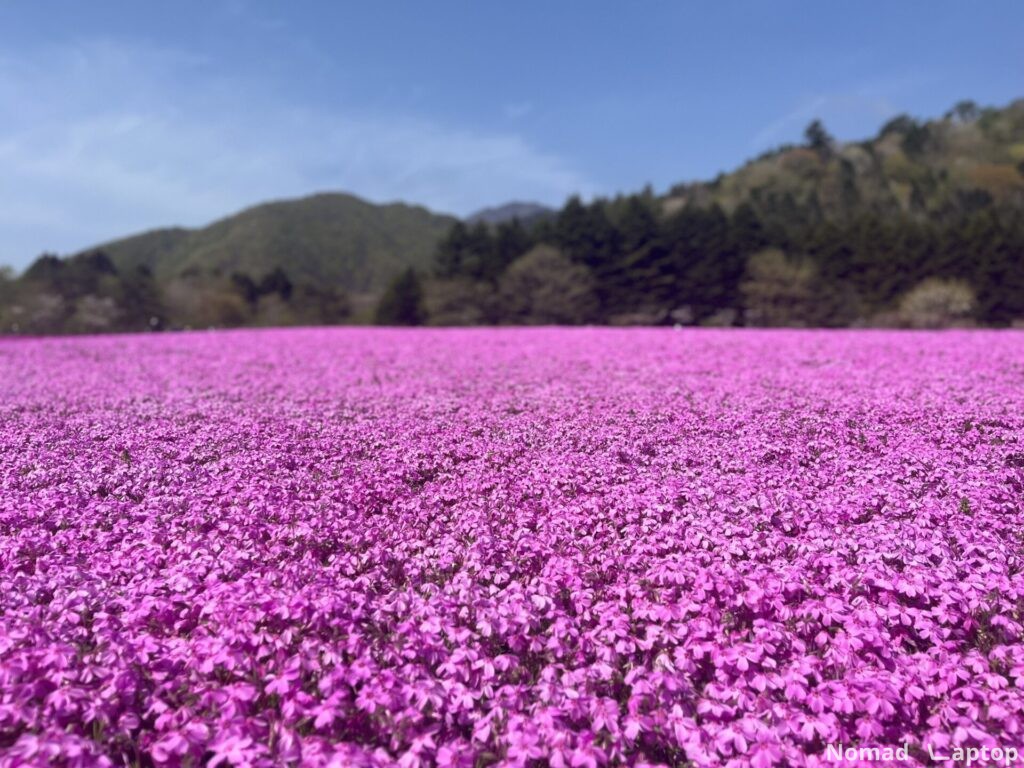
Lake Motosu is the deepest of the lakes. It is famous for its yearly Fuji Shibazakura or pink moss festival, which offers arguably the most stunning view of Fuji.
The cover photo of this post was taken there. Between the week-long stay in Tokyo waiting for my driver’s license translation, the car rental, and the waiting for the pink moss phlox season to be in full bloom and going there during the fully booked and expensive Japan Golden week, it might be the most expensive photo ever taken in history. Totally worth it though.
Fuji Shibazakura Festival
The name Shiba-Sakura means “lawn cherry” and these flowers are similar to cherry flowers but are of a creeping plant of the phlox species which bloom later with respect to cherry blossoms. It is an almost breathtaking sight to see this delicate pink carpet, or rather sea, of hundreds of thousands of Shiba-Sakura pink moss flowers below the ever-present gaze of Fuji-yama.
The festival is held at the Lake Motosuko Resort and the blooming of the flower occurs between April and mid-May. Apart from the wonderful gardens and dozens upon dozens of picturesque spots, there is a wonderful “on theme” cafe of the garden of Peter Rabbit, which is often packed with visitors just waiting to have upscale tea, biscuits, and cake while bathing in the sun and taking in the view.
Lake Yamanaka
山中湖
Lake Yamanaka is the largest of the 5 lakes and the shallowest, being the only one with an outlet given by the river Sagami. This is the only which I did not visit but it is a popular destination for water sports such as water-skiing and windsurfing, given its larger surface.
